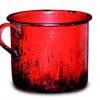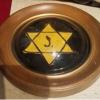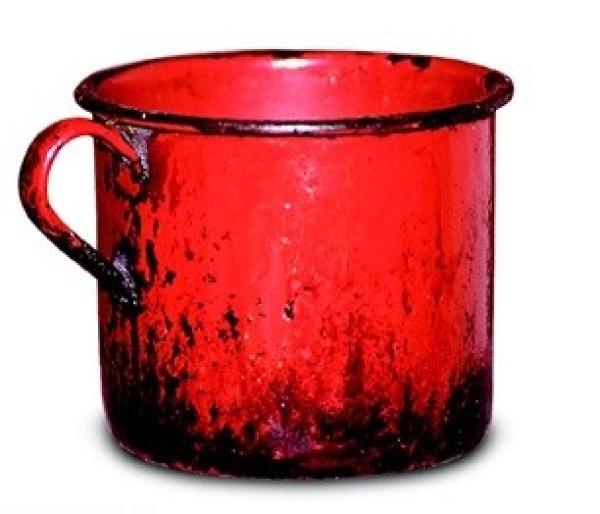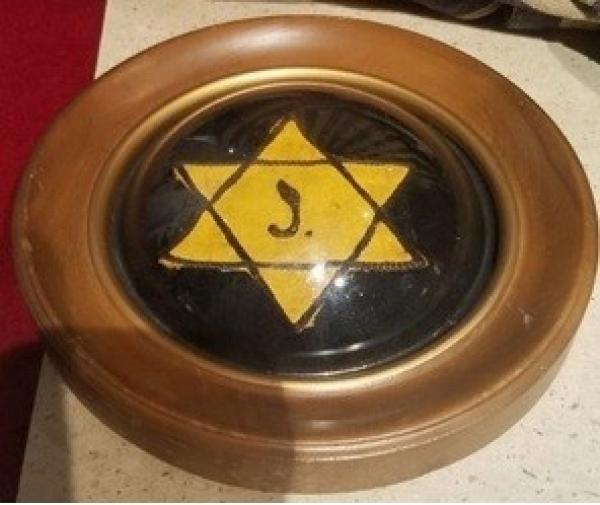Symbols of the Holocaust
| Grade | 9th -12th Grades | Class | History | Length of Lesson | 1-1.5 day |
| Lesson Title | Symbols of the Holocaust |
| Unit Title | |
| Unit Compelling Question | |
| Historical Context: This cup, which was made in Oskar Schindler's factory, was brought to Des Moines in 1947 by the Karp family. The Karps were natives of Poland and were sent to the concentration camp at Auschwitz during World War II. Oskar Schindler rescued the family from the concentration camp and transported them to Brunnlitz, Czechoslovakia, where they worked in his factory until the end of the war. When Phyllis Karp was asked why she wanted to bring the cup to the United States, she said "This will remind me, every day, that there is a better tomorrow." The Karp family (Irvin, Phyllis and their only child, Celina) were transferred to the Plaszow labor camp after the Krakow ghetto where they lived was evacuated in March of 1943. In September 1943, a new law required prisoners to stay within the confines of the camp to work rather than travel to work in factories. Factories were opened in the camp, however after one year, they closed due to the approaching Russians. Oskar Schindler, one of the factory owners, relocated his factory to Czechoslovakia. At this time, the Karp family was relocated to Auschwitz until they were smuggled into Czechoslovakia under Schindler's care. After the surrender of Germany, the Karp family moved to the United States in 1947, where they were met by David Karp who drove them to Des Moines, IA where he lived. Celina went on to attend Grinell College and became an elementary teacher while sharing her story with others. During World War II, the Nazi government used badges such as this one to identify Jewish people. This badge was worn by Charles Anolik when he lived in the Slobotka Ghetto in Lithuania. Charles Anolik was born in Kaunas, Lithuania in 1917 to Jakov and Mina Anolik and was a survivor of the concentration camp Dachau. After moving to Des Moines in 1949, Anolik opened and operated Salon Charles for nearly 50 years. Badges such as the one pictured and worn by Anolik, were required by Jews to wear to distinguish them from others. This program was introduced by Reinhard Heydrich and by 1939 all Jews were required to wear them. Those who refused to wear risked punishment or death. Both objects are in the collection of the Iowa Jewish Historical Society. ### A symbol is a tangible artifact that represents an abstract concept. The American flag represents the nation, its people, history, and values. Because symbols can evoke strong emotional responses, they can create strong conflicts when people understand them in different ways, . Civil War monuments are a good example in the present day of how a statue can be a symbol of heroic courage to preserve a homeland or of the defense of slavery and racial oppression. In the 1930s as Hitler and the Nazis came to power, Germans were suffering economic hardship and national shame at the loss of WW I. Hitler blamed the nation's problems on the Jews. Their civil rights were taken away and they were subject to public shaming. Some Jews fled, but Hitler began revoking their passports and refused them the right to leave. According to the Holocaust Encyclopedia, "After the September 1939 German invasion of Poland (the beginning of World War II), anti-Jewish policy escalated to the imprisonment and eventual murder of European Jewry." . Six million Jews were systematically killed, and millions more had their lives disrupted. Some Nazi death camps have been preserved as museums that testify to the reality of this unspeakable atrocity. Aschwitz and Trblinka in Poland are two of the most infamous. Local monuments to the Holocaust around the world keep the memory of that period alive. However, some of the most powerful symbols are everyday objects owned by Jewish victims that bring home their ordinary humanity. At the Holocaust Museum in Washington, DC, there is a room filled with the shoes of Jews they removed as they entered the gas chambers. Looking at them, the visitors recreate the last moment in the lives of the thousands of owners of those shoes. A drinking cup, a bracelet--any items preserved from the victims remind viewers that of their humanity. In recent years, some right-wing political groups have tried to deny the reality of the Holocaust. The symbols are powerful evidence that the Holocaust was real. Preservation of the death camps, museums, and thousands of items in local museums are a ever-disturbing reminder of a modern day atrocity. Post-war sympathy for the Jews led to the creation of the nation of Israel to provide a Jewish homeland. |
|
| Lesson Supporting Question | |
| Lesson Overview | This lesson incorporates reading standards/classes and history standards/classes. The purpose of this is to show the importance of cross-discipline understanding. It is the first day of the unit where the students will learn about the Holocaust |
| Primary Sources Used |
|
| Resources Needed | |
| Standard | |
| Lesson Target | |
| Lesson Themes | Civil Rights, Religion, Communal Groups, World War II |
|
| Formative Assessment (How will you use the formative assessments to monitor and inform instruction?) |
In this lesson the students will complete a K-W-L chart. The students will most likely already have had exposure to details of the Holocaust, therefore, the K-W-L chart will be beneficial to know of any misconceptions that need to be cleared up. The students have also recently gone through the WWII unit and will have many names and places fresh in their memory. , During the lesson,the students will complete a scavenger hunt around the classroom. They will pick four symbols from around the room, two that have historical significance and two that do not. During the lesson, I will also have probing question prepared to quickly assess how well the class is understanding what symbols are and what it means to be a citizen. Depending on responses, I will determine an appropriate amount of time for the active lecture. |
| Summative Assessment (How does the lesson connect to planned summative assessment(s)?) |
During this lesson the unit project will be assigned. This project is a personal video where students pick a person or group and symbol associated with the Holocaust. The students’goal will be to analyze each person/group and symbol through the lens of three different points of view. These videos will be published online for the class to watch. Students will use their understandings of historical symbols and choose an object that is important to them. Each student must explain why the object is symbolic and take on perspectives of three other groups to analyze their object. The students will receive the rubric and be assessed on a criterion-based rubric. |
| Author | Glenna Whiteman | Created | Last Edited | ||||
| Reviewer: Dr. Lisa Millsaps, University of Northern Iowa | |||||||
| Lesson Plan Development Notes: Teaching Methods, University of Northern Iowa, Fall 2018 | |||||||




